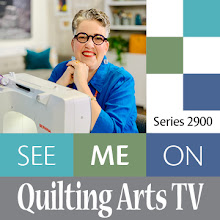A free “use me and share me!” pattern by Susan Brubaker KnappCheck out all the other great free patterns for hand-made last minute holiday gifts offered through Cotton Spice this November at www.cottonspice.com/CSblog/
If you’d like to print out a copy of this pattern, click here to download the
PDF.

MATERIALS:
- Scraps of fabric for outside
- Piece of fabric for backing approximately 10″ square
- button or charm
- perle cotton or thread (to tie button or charm)
- 1″square Velcro
- thread for piecing and quilting
- batting, approximately 10″ square
- caribeener clip
DIRECTIONS:
Please read all the directions before you begin!
1. Measure your cell phone. Use this formula to determine how big to make the outside of your pouch:
Width: (cell phone width x 3) + 1″
Length: cell phone length + 2-1/2″
For example, my phone is 2″ wide so I needed a piece 2″wide by 3-1/2″long, so I needed a piece for the outside that was 7″x 6″.

2. Sew your scraps together to create a piece for the outside of your pouch. Cut a piece of batting 1/2″longer and wider than your outside piece. Cut or piece a backing piece 1/2″longer and wider than your batting piece. Layer in this order: backing piece (face down); batting; pieced outside (face up).

3. Pin and quilt. An overall quilting motif that is fairly small is best. I used a square spiral on one pouch, and a pebble design on the other. Trim this piece for the outside of your pouch, using this formula:
Width: (cell phone width x 2) + 2-1/2″
Length: cell phone length + 1-3/4″
For my phone, I needed to trim my outside piece to 6-1/2″ wide by 5-1/4″ long.


4. Cut a strip of fabric 2″ long by the width of your piece. (In my case, this was a piece 2″ x 6-1/2″.) Fold it in half lengthwise, right sides out, and press. Pin it to the top edge of the outside, with raw edges aligned. Sew the strip to the outside with a 1/4″ seam.

5. Fold the binding around to the back of the outside and pin. From the front, sew right under the binding edge, catching the folded edge on the back side.

6. Fold the outside, right sides together, with the binding at the top. Pin along the raw edges, and sew a 1/4″seam.

Then zig-zag along the same raw edges. Take care and go slowly; you are sewing through many bulky layers.

7. Turn the pouch right side out.

Cut a 1″ piece of Velcro. Take one half and position it at the center of the inside back, just under the binding, and sew it down. Take the other half and position it at the center of the inside front, just under the binding, and sew it down.

8. For the loop, cut a piece 4×2″. Fold it in half lengthwise, right side out, and press. Then fold in and press each side again. This leaves the raw edges inside the strip.

Topstitch very close along both long edges.

9. Sew the strip together in a circle by folding it in half, and then making a 1/4″ seam along the short raw edge. Turn right side out. Fold the loop in half, tucking the seam at one end. Pin the loop to the top of the back of the pouch, and sew it down so that this spot is trapped in the new seam and does not show. Take care and go slowly; you are sewing through many bulky layers.

10. On the front, hand sew on a button or charm at the top. This makes it easier to pull the pouch open when you need to get out your phone.

If you add a caribeener clip to the loop, you can clip your cell phone pouch to your purse strap, belt, or to a loop inside your purse. You are done! Enjoy!







































































